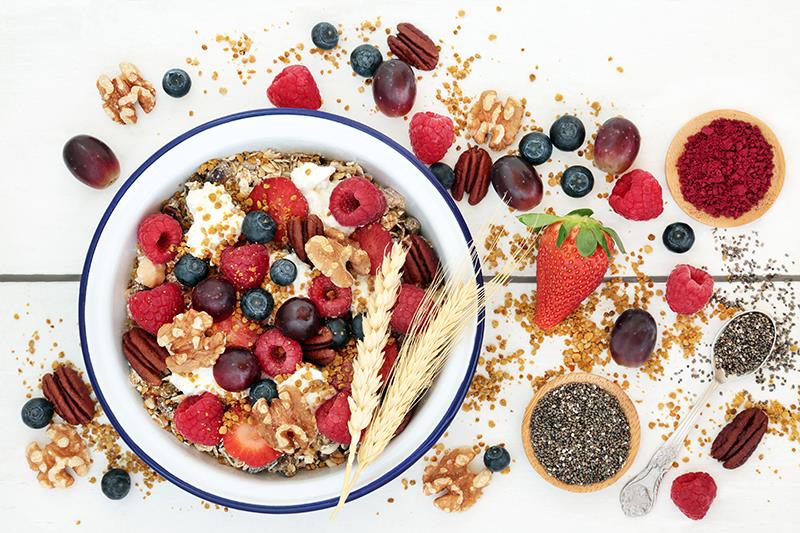High-fibre diets in blood cancers: What do we know?





High-fibre diets improved blood cancer outcomes in two studies reported at ASH 2024.
With high-fibre intake, patients undergoing allogeneic hematopoietic cell transplant (allo-HCT) had significantly better survival and lower graft-versus-host disease (GVHD) in the first study. [ASH 2024, abstract 259]
“When a patient is facing a diagnosis of cancer or some other blood disorders, the emotional response to that is to ask, ‘What did I do to be in this situation?’ or ‘What can I do to resolve this situation?’” said Dr Chancellor Donald of Tulane University School of Medicine in New Orleans, Louisiana, US, who moderated the press briefing. “One of the things we have the greatest control over is our lifestyle and diet. This research speaks for lifestyle modification.”
Fibre diet in Allo-HCT patients
Dietary information was collected from 173 patients who underwent allo-HCT. Included were 35,228 meals and 3,837 days of tracking, corrected for consumed portions and dry grams per nutrient. Fibre intake was classified as either high or low.
Fibre intake positively correlated with Blautia (a butyrate producer) and negatively correlated with Enterococcus. There was also a positive correlation between high fibre intake (as assessed on day 12 after allo-HCT) and overall survival (p=0.045) out to 24 months.
The researchers also examined 101 non-T cell-depleted patients and identified 29 who developed lower gastrointestinal (GI) GVHD and 29 who did not. Samples of small-chain fatty acids were obtained from both groups.
High fibre intake was associated with greater microbiome α-diversity (p=0.007) and β-diversity (p<0.001) in those with lower GI-GVHD. Faecal butyrate and acetate concentrations (p<0.001 for each) were reduced in association with low fibre intake in the lower GI-GVHD group and were lower in the GVHD than the non-GVHD groups (p=0.007 and p=0.008). Interestingly, high fibre intake had a significant negative association with acute GVHD incidence (p=0.034).
When the researchers examined dietary fibre intake in pre-clinical models of GVHD, the highest fibre intake was associated with better GVHD survival. Increasing fibre intake was associated with greater microbial diversity (p=0.001) and butyrate production (p=0.065) and reduced abundance of Enterococcus (p=0.044).
Other favourable effects included increased gene expression related to epithelial homeostasis, caecal butyrate, the ratio of regulatory T cells, reduced T cell-mediated inflammation, and prevention of gut barrier damage.
Fibre diet and myeloma
In the second study, Dr Urvi Shah of Memorial Sloan Kettering Cancer Center (MSKCC) in New York City, New York, US and her team sought to determine whether a plant-based diet can affect the trajectory of monoclonal gammopathy of unknown significance (MGUS) and smouldering myeloma and delay the progression to multiple myeloma (MM), a rare and incurable blood cancer affecting the bone marrow. Twenty patients with a BMI >25 kg/m2 met the diagnostic criteria for the two myeloma precursors. [ASH 2024, abstract 671]
The patients consumed plant-based, high-fibre meals for 12 weeks and had health coaching for 24 weeks. The study's primary endpoint was feasibility, defined as >70 percent adherence to the meals and BMI reduction >5 percent at 12 weeks. Follow-up continued for a total of 52 weeks.
During the first 12 weeks, adherence to the diet was 91 percent. At 52 weeks, 58 percent remained adherent. Median BMI reduction was 7 percent at 12 weeks and maintained up to 52 weeks.
Additionally, the patients had favourable changes in biochemical markers, including insulation resistance, faecal microbiome diversity, inflammation, and improved quality of life.
“Two patients with progressive disease had the progression stabilize and slow down on the intervention,” said Shah. “To our knowledge, it has not been shown in any intervention setting that you can improve diet and lifestyle and slow or change the disease trajectory. Our study showcases the power of nutrition and unlocks a better understanding of how it can improve the microbiome and metabolism to build a stronger immune system.”
“These findings further support how we as physicians can empower patients, especially those with precancerous conditions, with knowledge on reducing their cancer risk through dietary changes,” she added.